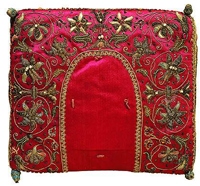09.30.2004 15:34
 28 September 2004 - 11 January 2005
28 September 2004 - 11 January 2005
16th – 19th Century Western European Embroidery from the Collection of the Hermitage
The exhibition in the Menshikov Palace presents around 100 works of applied art made in Italy, France, Germany, Spain, and the Netherlands during the 16th – 19th centuries. Many of these works are being displayed for the first time.
Secular works of embroidery include panels that were used as wall decorations, furniture upholstery, bed covers, table cloths, parts of women’s skirts, and hats. Religious works include sacramental vestments as well as decorative elements for the clothing of clergy.
Embroidery from the 16th and 18th centuries is the most varied. It is also worth mentioning a separate but related type of work, decorative finishing: white tassels made from linen threads; tassels from colored silk and metallic thread; fringes; and piping.
Superb examples of French embroidery demonstrate a previously unknown flowering of decorative embroidery, which occupied an important place in the interiors of palaces. It complemented the opulence of room décor and was one of the elements of an elaborate ceremony at the royal court. However, in the 18th century, when the general stylistic changes in art also influenced embroidery, the character of embroidery changed and it lost its monumental character. At this time emphasis shifted to embroidery intended for decorating clothing. At the exhibition one can see a whole range of examples of decoration for men’s outer wear made from different materials and adorned not only with silk but also sequins, colored glass and foil. These reflect the 18th century attraction to cheaper materials which could be used in place of gold and precious stones to create an effect of luxury. Miniature patches of fabrics with stitched design were sold in fashionable stores where one could also order embroidery to cover entire vests or sleeveless jackets.
Embroidery by 18th century German masters is also on display. They were once used as reference material and design models to train apprentice embroiderers in the craft. These samples are swathes of cloth with rows of embroidery on them, demonstrating various methods and stitches. They were exercises for the students to follow as they learned the techniques.
In Russia collecting applied art of this sort began in the last third of the 19th century. One of the first connoisseurs was A.P. Bazilevsky. The items which he found in antique shops as well as in old church storerooms formed the collection which entered the Hermitage in 1885. In the second half of the 19th century artistic institutions to train designers appeared. One of the largest was the Central School of Technical Drawing, which Baron A. L. Stieglitz opened in St Petersburg in 1879. Later he oversaw the creation of a museum of decorative and applied art for which major acquisitions were made at auctions in Vienna, Paris and London. After the 1917 Revolution, all the collections of this museum were transferred to the Hermitage.
Today the State Hermitage’s collection of embroidery includes around 1500 works and provides an overview of the development of this art form in a number of different European countries over the course of several centuries
News source: hermitage.ru
 Print this news Print this news
Culture news archive for 30 September' 2004.
Culture news archive for September' 2004.
Culture news archive for 2004 year.
|